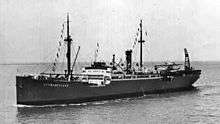MS Schwabenland (1925)
 Schwabenland before 1939 | |
| History | |
|---|---|
| Name: | SS Schwabenland |
| Namesake: | The region of Swabia in Germany |
| Launched: | 1925 |
| Refit: | 1934 |
| Fate: | Loaded with poison gas shells and scuttled, 31 December 1946 |
| General characteristics | |
| Type: | Steamship |
| Tonnage: | 8,500 GRT |
| Propulsion: | Twin diesel screws |
| Speed: | 12 knots (22 km/h; 14 mph) |
| Aviation facilities: | Crane and catapult for flying boats |
The MS Schwabenland was a German catapult ship owned by the Deutsche Luft Hansa. It took part in the 1938-1939 Third German Antarctic Expedition.[1]
Characteristics
The Schwabenland was a Hansa liner of 8,500 GRT, built in 1925. It was converted into a catapult ship in 1934; a Heinkel-built K-9 catapult was installed on the ship's stern, along with a crane for lifting aircraft. The K-9 could accelerate a 15-ton aircraft to 94 miles per hour (151 km/h). The Schwabenland's twin diesel screws gave it a speed of 12 knots.[2]
Lufthansa air mail
Lufthansa sought to engage in air mail service to the Americas using seaplanes launched off catapult ships, with the Schwabenland being the second of those ships. The craft flew with a payload of 500 kg (1,102 lbs) over 5,000 km (3,166 miles);[3] each flight carried 100,000 air mail letters.[4]
Two Dornier Do 18 Lufthansa seaplanes christened Zephir and Aeolus were used for air mail flights from the Azores to the United States and from Fernando de Noronha to Natal.[5]
Third German Antarctic Expedition
The Schwabenland was borrowed from Lufthansa for the 1938-1939 Third German Antarctic Expedition. The ship sailed in secret from Hamburg on 17 December 1938, carrying a complement of 82 men and two Dornier Wal seaplanes. The ship contacted the German whaling fleet off Bouvet Island, then anchored near the edge of the pack ice at 69°14′S, 4°30′W. After the expedition had completed its work, the Schwabenland headed north on 6 February 1938, reaching Germany again on 11 April.[6]
World War II and fate
In October 1939 the Schwabenland entered Luftwaffe service and used Blohm & Voss BV 138 seaplanes. After the fall of France it was stationed off the coast of Occupied France, based from the ports of Le Havre and Boulogne.[7]
In August 1942 it was transferred to Tromsø, Norway.[8]
The ship was damaged and forced to beach by the British submarine Terrapin in 1944 off Bergen, Norway, and later refloated. When the war ended, the ship was taken by the British, and on 31 December 1946 it was loaded with poison gas ammunition, and scuttled in the Skagerrak.[9]
References
- ↑ "The Schwabenland in the Antarctic". The Geographical Journal. The Royal Geographical Society (with the Institute of British Geographers). 95 (1): 52–54. January 1940. doi:10.2307/1788684. JSTOR 1788684.
- ↑ Marriott, Leo (2006). Catapult aircraft : the story of seaplanes flown from battleships, cruisers and other warships of the world's navies, 1912-1950 (1. publ. in Great Britain. ed.). Barnsley: Pen & Sword Aviation. pp. 101–105. ISBN 184415419X.
- ↑ Dancey, Peter Lufthansa to Luftwaffe-Hitlers: Secret Air Force Lulu Press, Inc, 12 Mar 2013
- ↑ "80th anniversary of trailblazing airmail flight across the South Atlantic". Lufthansa Group. Deutsche Lufthansa AG. 30 January 2014. Retrieved 3 September 2015.
- ↑ Grosschopff, Robert (2010). "South Atlantic Mail Services". southatlanticflight.com. Retrieved 3 September 2015.
- ↑ Mills, William James; et al. (2003). Exploring polar frontiers : a historical encyclopedia (Volume 1). Santa Barbara, Calif. [u.a.]: ABC-CLIO. pp. 552–553. ISBN 978-1576074220. Retrieved 3 September 2015.
- ↑ p. 420 Warship International, Volume 27 International Naval Research Organization, 1990
- ↑ Page 420 Warship International - Volume 27 1990
- ↑ Greenway, Ambrose (2011). Cargo liners : an illustrated history (New ed.). Barnsley: Seaforth Pub. p. 66. ISBN 978-1848321298. Retrieved 3 September 2015.
External links
- The Interesting History of the Lufthansa Catapult Ships http://www.steelnavy.com/1250DLHships.htm
- Wreck site http://www.wrecksite.eu/wreck.aspx?93451
- Photos https://translate.google.com.au/translate?hl=en&sl=de&u=http://www.seefunknetz.de/dofw.htm&prev=search
Coordinates: 58°10′22″N 10°45′24″E / 58.1728°N 10.7567°E